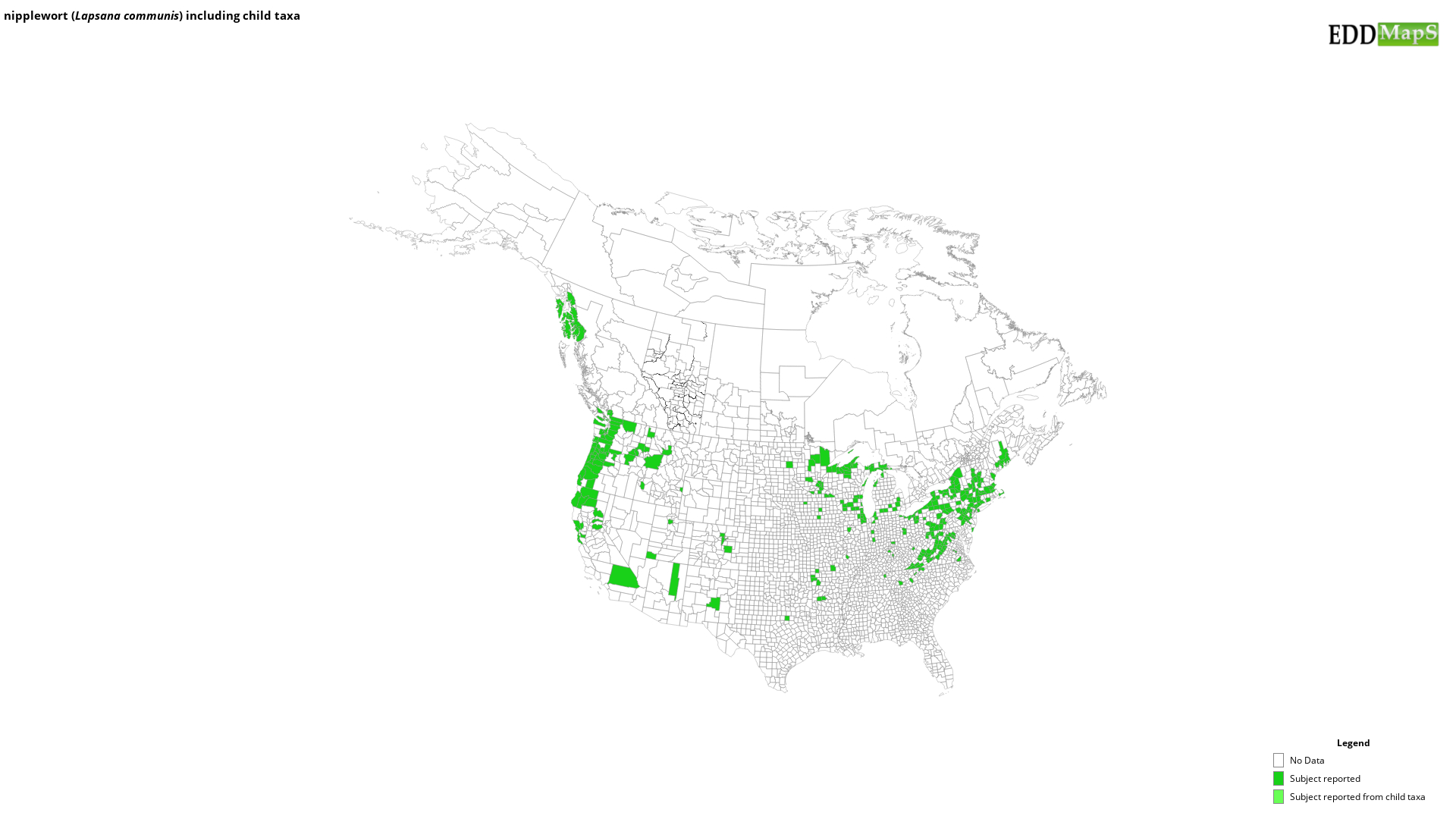nipplewort
(Lapsana communis)
This species is Introduced in the United States
ORIGIN: Eurasia
GROWTH TRAITS: Herbaceous winter annual that grows from a large taproot. Rosettes form either in fall and overwinter, or they grow in spring. Stems bolt later in spring and can grow 12-49" (30-125 cm) tall. Stems are greenish-red, rounded, and slightly ridged. Stems branch above the midstem and are generally hairy, though they become less so towards the top. Leaves are alternate, thin, and may have sparse hairs on their upper surfaces with slightly more scattered hairs on their undersides. Leaves have scalloped, wavy margins, and a wrinkled appearance. Basal leaves are up to 6" (15 cm) long, broadly triangular, and have two smaller, side lobes along their petioles. Upper leaves are more elliptical, often lack petioles, and decrease in size towards plant tips. The stems and leaves exude a milky sap when damaged. Flower heads are dandelion-like and produced on branched stalks spring through fall. Each flower head is up to 0.5" (1.2 cm) in diameter with 8-20 yellow, notched florets. Flower heads produce numerous golden brown seeds that are 0.1-0.2" (3-5 mm) long, curved, ribbed, bulge slightly at their base, and have no pappus.
REPRODUCTION: Spreads by seed. Most seeds germinate within 2-3 years, but a small number may remain viable for up to five years.
HABITAT: Common nipplewort is a temperate species that can tolerate a variety of soils. It grows best in full to partial sun in areas of disturbance, including gardens, roadsides, waste lots, fields, forest edge, and riparian shores.
LOOK-ALIKES: The yellow dandelion-like flower heads and milky sap help differentiate common nipplewort from many unrelated look-alikes. Within the same family, prickly lettuces (Lactuca spp.), sowthistles (Sonchus spp.), and hawkweeds (Pilosella spp.) are very similar. Prickly lettuces and sowthistles have spiny leaves and pappus on their seeds. Hawkweeds are only branched near the tips, have mostly basal leaves, and pappus on their seeds.
CITATIONS:
Rawlins, K.A., R.L. Winston, C.T. Bargeron, D.J. Moorhead, and R. Carroll. 2018. New Invaders of the Southeast. USDA Forest Service, Forest Health Assessment and Applied Sciences Team, Morgantown, West Virginia. FHTET-2017-05. Retrieved from http://bugwoodcloud.org/resource/pdf/FHTET-2017-05_New%20Invaders_SE.pdf
GROWTH TRAITS: Herbaceous winter annual that grows from a large taproot. Rosettes form either in fall and overwinter, or they grow in spring. Stems bolt later in spring and can grow 12-49" (30-125 cm) tall. Stems are greenish-red, rounded, and slightly ridged. Stems branch above the midstem and are generally hairy, though they become less so towards the top. Leaves are alternate, thin, and may have sparse hairs on their upper surfaces with slightly more scattered hairs on their undersides. Leaves have scalloped, wavy margins, and a wrinkled appearance. Basal leaves are up to 6" (15 cm) long, broadly triangular, and have two smaller, side lobes along their petioles. Upper leaves are more elliptical, often lack petioles, and decrease in size towards plant tips. The stems and leaves exude a milky sap when damaged. Flower heads are dandelion-like and produced on branched stalks spring through fall. Each flower head is up to 0.5" (1.2 cm) in diameter with 8-20 yellow, notched florets. Flower heads produce numerous golden brown seeds that are 0.1-0.2" (3-5 mm) long, curved, ribbed, bulge slightly at their base, and have no pappus.
REPRODUCTION: Spreads by seed. Most seeds germinate within 2-3 years, but a small number may remain viable for up to five years.
HABITAT: Common nipplewort is a temperate species that can tolerate a variety of soils. It grows best in full to partial sun in areas of disturbance, including gardens, roadsides, waste lots, fields, forest edge, and riparian shores.
LOOK-ALIKES: The yellow dandelion-like flower heads and milky sap help differentiate common nipplewort from many unrelated look-alikes. Within the same family, prickly lettuces (Lactuca spp.), sowthistles (Sonchus spp.), and hawkweeds (Pilosella spp.) are very similar. Prickly lettuces and sowthistles have spiny leaves and pappus on their seeds. Hawkweeds are only branched near the tips, have mostly basal leaves, and pappus on their seeds.
CITATIONS:
Rawlins, K.A., R.L. Winston, C.T. Bargeron, D.J. Moorhead, and R. Carroll. 2018. New Invaders of the Southeast. USDA Forest Service, Forest Health Assessment and Applied Sciences Team, Morgantown, West Virginia. FHTET-2017-05. Retrieved from http://bugwoodcloud.org/resource/pdf/FHTET-2017-05_New%20Invaders_SE.pdf
Maps
EDDMapS Distribution - This map is incomplete and is based only on current site and county level reports made by experts, herbaria, and literature. For more information, visit www.eddmaps.org
State Lists - This map identifies those states that have this species on their invasive species list or law.
Invasive Listing Sources
- Invasive Plant Species of West Virginia
- Jil M. Swearingen, Survey of invasive plants occurring on National Park Service lands, 2000-2007
- National Park Service, Mid-Atlantic Exotic Plant Management Team Invasive Plant List
- Native Plant Society of Oregon, 2008
- New Invaders of the Southeast
- Nonnative Invasive Species in Southern Forest and Grassland Ecosystems
- WeedUS - Database of Plants Invading Natural Areas in the United States
- West Virginia Native Plant Society, Flora West Virginia Project, and West Virginia Curatorial Database System, September 3, 1999
Taxonomic Rank
| Domain: Eukarya |
| Kingdom: Plantae |
| Phylum: Magnoliophyta |
| Class: Magnoliopsida |
| Superorder: Asteranae |
| Order: Asterales |
| Family: Asteraceae |
| Subfamily: Cichorioideae |
| Tribe: Cichorieae |
| Genus: Lapsana |
| Lapsana communis |
References
Common Name Reference: Weed Science Society of America Common Names List
Scientific Name Reference: USDA, NRCS. 2010. The PLANTS Database. National Plant Data Center, Baton Rouge, LA, USA.


